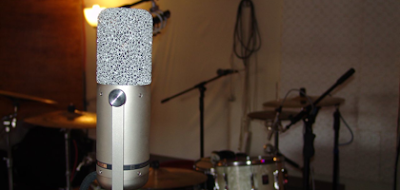Back in August we were lucky enough to get our hands on a special edition Josephson C720 microphone for the studio, one of only 20 made in the first production run, and having lived with this for nearly half a year it’s probably about time we reviewed it.

The first thing you notice about the C720 is its size – this is one big mic, U47-big, and makes a big bold statement in the live room or vocal booth – it’s built like a tank and it definitely has that ‘wow’ factor which gets the artists talking.
The next thing that grabs your attention is its radical aluminium metal-foam headbasket, which looks like something you could scrub your pots and pans with. The non-periodic headbasket is actually designed to eliminate internal acoustic reflections and refraction of soundwaves, avoiding comb-filtering effects and so giving a more realistic recording.
The third thing you notice is that it has two XLR outputs. Like many condenser microphones, the capsule has dual diaphragms which can be combined in different combinations to give cardioid, omni, figure of eight patterns. Unlike most microphones, the two transducers have separate head amplifiers and separate outputs which means that the signals from opposite sides of the microphone can be recorded separately and mixed together, either in phase or with the polarity reversed, at a later stage. What this innovation means in practice is that you can pick the polar pattern after recording, which might be used to eliminate unwanted sound sources by rotating the null point of the microphone. Also, and more importantly in our studio use, with close-mic’ed sources such as vocals you can dial in more or less proximity effect, making a singer seem bigger, darker or lighter and brighter.
So what does it sound like? Possibly because of the lack of head basket comb filtering, and the facility to tune the pattern and proximity effect, this is a very versatile microphone. The one word that sprang to my mind in describing the sound, whichever pattern you pick, is ‘solid’.*
Another thing we’ve noticed is it sounds pretty damned good on pretty much anything you can throw at it. Because of it’s ability to handle high sound pressure levels and become a go-to mic for low end stuff, and is rock-solid on bass guitar and front of kick drum, but it’s just as handy on both male and female vocals – especially those with a tendency to get loud when they belt it out. Vocal recordings are up front, sound as they should, but without the top end brightness of, say, our TLM49.
Furthermore, it can be used for more radical effects by compressing or reverberating one side of the capsule only. For example, I had some interesting results on a male rock vocal by compressing the signal from the front capsule, mixing together with the phase reversed rear capsule, then compressing the sum of these. The effect was that as the vocals push harder, the relative amount of rear capsule included becomes greater giving it more of a hypercardioid pattern, balancing the tendency of the vocalist to step back from the mic when belting it out. With a bit of creativity the possibilities are endless.
Overall this is a brilliant, radical piece of thinking and and one of those bits of gear that comes into your life and is there to stay.
*After writing this I read another review of this mic which used exactly the same word – ‘solid’ – to sum up the sound.